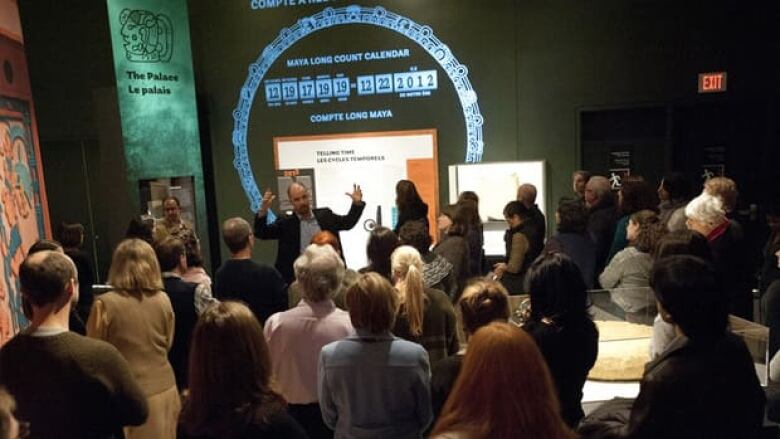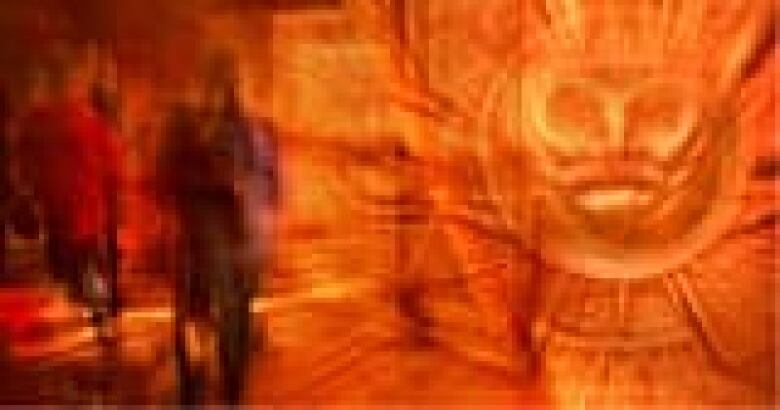Did the Maya predict the world would end in 2012?
Archeologists say Maya made no such prophecy

For true believers,the ancient Maya calendar is a prime source for the prophecy thatsomething very big is going to happen this year, 2012. Perhaps eventhe end of the world, or a transformation into a new age.
To backup the apprehension over 2012, some will also point tothe I Ching and Nostradamus as predictors of note. Though it may also be worth observing thatonly a few days into this new year, the Rapture Index is just one point below its all-time high.
The index, a feature on Rapture Ready, an evangelical Christian website, tracks natural and political events that may portend how close we are to the apocalypse and the Second Coming of Christ.
The website doesn't have a date for the big day but quotes the Bible on why such a date cannot be known in advance.
That is not the case for other doomsdayers, however, who predict Dec. 21, 2012 is when time, or the world, will end. (Rapture Ready advises that it could happen before December.)
Still, it is the Maya, a civilization in southern Mexico and northern Central America for about 2,500 years, that seems to be taking centre stage these days, perhaps particularly in Canada where they are the subject of aspecial exhibition at the Royal Ontario Museum as well asa documentarypresented Jan. 5on CBC TV's Doc Zone.
Um, might the doomsayersbe right?
'Complete nonsense'
Until recently, Maya scholars had been reluctant to respond to the discussion aboutthe 2012 prophecy because "it's all complete nonsense," as one of the foremost scholars, David Stuart, put it in the preface to his 2011 book, The Order of Days: the Maya and the Truth about 2012.
Back in 1999, inanother scholarly book on the Maya, The Code of Kings, Linda Schele and Peter Mathews thought that a footnote was sufficient to dismiss the belief that the Maya predicted the end of the world in 2012.
They noted that a Maya ruler of Palenque had written about specific dates and events to come long after our calendar's 2012.
"The world-ending myth is a modern 'prophecy' that has no basis in the ancient Maya texts," Schele and Mathews wrote.
Since then, however, the myth has only grown in popularity.

That popularity, of course, has created both opportunity anda challenge for the Royal Ontario Museum in Toronto, which is currently exhibiting "Maya: Secrets of their Ancient World."
The Maya calendar is just one part of the exhibition, but archeologist and co-curator Justin Jennings says that some visitors expect more. "People want to see the Calendar Stone," he told CBC News. "They want to see the 2012 reference, they want to see the prophecy about the end of days and that's the thing about the Maya, people come with so many misconceptions."
Although frequently misidentified as Maya, what's known as the Calendar Stone, or Sun Stone, is Aztec and not referenced in the ROM show. It dates from the early 15th century, near the end of the Aztec empire and is now a national symbol of Mexico. The stone has nothing about 2012, nor is there any historical record that even suggests the Aztecs were aware of the Maya date.
In his book, Stuart writes that its misrepresentation as Maya "reflects a dismissive and woefully ignorant collapsing of two very distinct Mesoamerican cultures."
And with no evidence there ever was such a Maya prophecy about 2012, there's no artifact for a museum to procure.
The end of a baktun
TheMaya long count calendardoes havea baktun endingin 2012, an epoch-like period for the Maya that corresponds to about 394 years, or 144,000 days.
Ina correlation of the Maya's long-count calendar to our Western one, the end ofthis currentbaktun, the 13th,happens on Dec. 21, 2012 (or Dec. 23. See sidebar).
The long-count calendar counts the time since creation, which the Maya date to what we would call a day in August 3114 BC.
Dec. 21 vs. Dec. 23
Dec, 21, 2012 seems to be the most favoured date for when the 13th baktun on the Maya long-count calendar ends. But some sources, including the Royal Ontario Museum,go with Dec. 23.
The two dates stem from two variations of the most used correlation of our calendar with the Maya's.
The ROM's Justin Jennings said itwent with Dec. 23 because, "there's no evidence that the long count is linked to astronomical cycles" andthe curators felt that Dec. 21 feeds into "2012 galactic alignment stuff, which just doesn't hold water from an astronomy point of view and it does not work for classic Maya literature."
Maya expert David Stuart doesn't care which date people choose but told CBC News that it is a complete coincidence that Dec. 21 will be the winter solstice. "Other baktun endings don't really fall on important astronomical dates," he noted.
Obviously, baktuns have come and gone. This year just happens to be the one when the13th baktun ends. The12th baktun ended on Sept. 18, 1618, which was when Europe'svery destructive Thirty Years' War was just getting started.
Stuart writes that, "any such statements about the Maya predicting the world's demise or alternatively, some 'transformation of consciousness' in 2012 is, to put it as simply and directly as possible, wrong."
So where does such a misunderstanding come from?
The myth is indeed a modern one but Stuart noted there was a reference made in the late 19th century by Ernst Forstemann, one of the first decipherers of the Maya's long-count calendar. (Forstemann was a German librarian in Dresden; the other main decipherer at the time was American journalist Joseph Goodman.)
Working with a Maya document known as the Dresden codex, Forstemann interpreted a scene on the last page as symbolizing world destruction. The scene portrays gods, some holding weapons, and a giant serpent with water spilling out of its mouth.
However, he did not connect that to the ending of the 13th baktun and, "Ironically, the scene is related to world creation," Stuart said.
"That set the stage for people to come at this with the idea that there was a Maya myth about the end of the world," he added.
In 1966, in the first edition of The Maya (the 8th edition of the book was published in 2011), Michael Coe, an American renowned for his expertise on the subject, speculated about the ways the Maya might have thought about the ending of the 13th baktun.
One way might have beenthe destruction of the world, based primarily on the nearby Aztecs' myths about world creation and destruction, Coe suggested.
However, Stuart said that Coewould admit, "then as now, no Maya source makes any such claim about 2012."
The 2012 idea catches on
In 1971, a popular American writer, Frank Waters, picked up onCoe's speculationin his book, Mexican Mystique.
Stuart told CBC News that until he began researchinghis own book, he was unfamiliar with Waters'book but thathe now considers itthe foundation forthose whoreally popularized the 2012 doomsday idea.
For Stuart that idea, "really has its origins in new age counter-culture mysticism as it tries to tie into Native American cosmology and world view."
Arguably the person who did the most to popularize the 2012 myth is Jose Arguelles, author of The Mayan Factor in 1987.
Arguelles is also famous for organizing the "Harmonic Convergence" in 1987, which was described as the first synchronized global meditation, withlarge-scale social change to follow, he predicted.
Arguelles believes that 2012 will be a year of cataclysmic change on Earth, followed by a new golden age, views which resemble the fundamentalist Christian belief in the End Times.
He also suggests thatthe ancient Maya were inter-galactic travellers who came to Earth, stayed a few centuries and left their clues, then moved on. (Arguelles also says that he channels a 7th century Maya ruler, Pacal Votan.)
The 2012 date important to the Maya
Meanwhile, the ROM'sJennings notes that while thisnew-age mythology is a modern idea, not from the ancient Maya, these"ends of time cycles for the Maya were huge deals," since they were fascinated with the passing of time.
"There's a grain of truth, in the sense that 2012 would have been a momentous year for classic Maya," he says, comparable to the start of a new century in the Western world.
Thirteen was alsoa significant number for the Maya asmost Mesoamerican cosmologies divided the sky into13 zones.
The ending of the 13th baktun, "probably would have been bigger than the ending of any of the other baktuns," Jennings speculated.
For his part, however, David Stuart cannot wait for it all to be over. He told CBC News that he finds it "hilarious" thatarcheologists such as himself "who are trying to communicate about this stuff are completely drowned out by the noise out there."
"The whole 2012 business is of our own making, not something the Maya ever talked about, and certainly didn't prophesize," he said, with some exasperation.
[IMAGEGALLERY galleryid=1461 size=large]












_(720p).jpg)


 OFFICIAL HD MUSIC VIDEO.jpg)
.jpg)



























































































